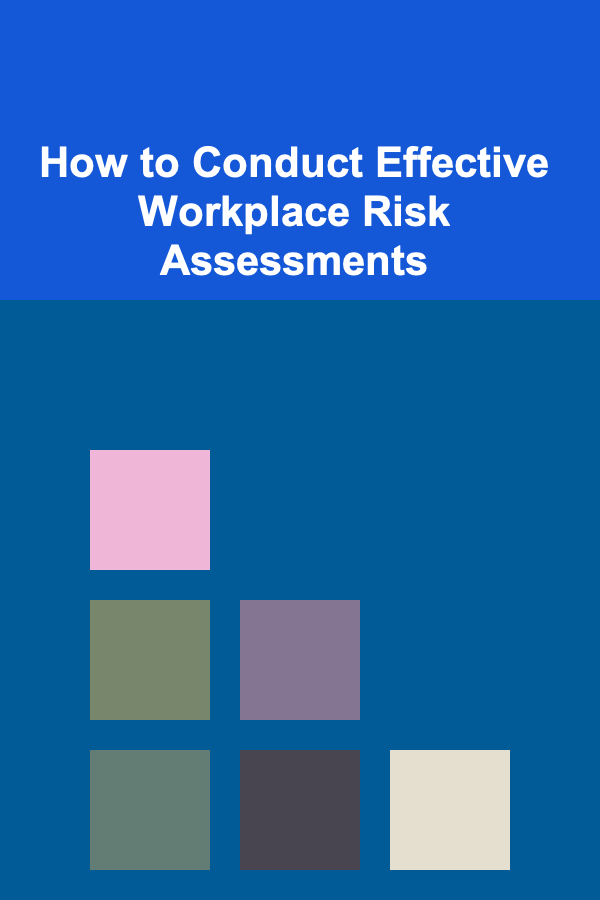
How to Conduct Effective Workplace Risk Assessments
ebook include PDF & Audio bundle (Micro Guide)
$12.99$10.99
Limited Time Offer! Order within the next:

In any workplace, ensuring the safety and health of employees is a top priority. One of the most fundamental ways to safeguard against potential hazards is by conducting effective workplace risk assessments. These assessments not only help in identifying risks but also in managing and minimizing them to create a safer work environment. Whether it's a small office, a large manufacturing facility, or any other type of workplace, risk assessments are vital in maintaining a productive, safe, and healthy workforce.
In this article, we will dive deep into the process of conducting effective workplace risk assessments, including their importance, the steps involved, and the strategies for continuous improvement.
What is a Workplace Risk Assessment?
A workplace risk assessment is a systematic process used to identify, evaluate, and manage potential hazards in the workplace. The goal is to minimize or eliminate risks that could harm employees, visitors, contractors, or anyone else on the premises. It involves identifying risks, evaluating the likelihood of these risks occurring, assessing the severity of their impact, and determining appropriate control measures to mitigate them.
Risk assessments are not one-time events; they should be conducted regularly and updated as conditions in the workplace change. A robust risk assessment process can help prevent accidents, injuries, and illnesses, leading to increased productivity, employee morale, and compliance with legal safety regulations.
Why Are Risk Assessments Important?
Before we delve into the step-by-step process of conducting a workplace risk assessment, it's essential to understand why they are so important.
1. Protecting Employee Health and Safety
The most obvious benefit of risk assessments is the protection of employee health and safety. Identifying risks before they cause harm allows employers to implement measures to prevent accidents, injuries, and illnesses. This proactive approach helps ensure a safer and healthier work environment for everyone involved.
2. Legal Compliance
Workplace safety laws and regulations vary by country, industry, and jurisdiction, but virtually all regions require employers to perform risk assessments to comply with occupational health and safety regulations. Non-compliance can result in legal penalties, fines, or even closure of the business. Conducting regular risk assessments helps businesses meet legal requirements and avoid costly legal issues.
3. Reducing Financial and Operational Risks
Workplace accidents can lead to costly consequences, including medical expenses, compensation claims, and legal fees. By identifying and addressing risks early, employers can reduce the likelihood of accidents and minimize the financial burden associated with workplace incidents. In addition, a safer workplace contributes to higher productivity, lower absenteeism, and improved employee satisfaction.
4. Fostering a Positive Work Culture
Employees feel valued and safe in workplaces where their health and safety are prioritized. Conducting risk assessments and addressing identified risks shows employees that their well-being matters. This leads to greater engagement, job satisfaction, and retention, ultimately improving the overall work culture.
Steps in Conducting a Workplace Risk Assessment
Conducting a workplace risk assessment is a structured process that involves several key steps. Each step is vital to ensure that the assessment is thorough, effective, and actionable.
Step 1: Identify the Hazards
The first step in any risk assessment is identifying potential hazards in the workplace. Hazards are any factors that have the potential to cause harm to employees, customers, or anyone else on the premises. There are many types of hazards to consider:
- Physical Hazards: Slippery floors, machinery, equipment, and tools.
- Chemical Hazards: Exposure to toxic substances, fumes, or vapors.
- Biological Hazards: Bacteria, viruses, mold, or other biological contaminants.
- Ergonomic Hazards: Poor workstation setup, repetitive motions, lifting techniques.
- Psychosocial Hazards: Stress, harassment, bullying, and workplace violence.
- Environmental Hazards: Poor ventilation, inadequate lighting, extreme temperatures, noise pollution.
By conducting site inspections, talking to employees, and reviewing previous incident reports, employers can begin to identify these hazards. Every area of the workplace should be assessed, including offices, production areas, break rooms, storage spaces, and outdoor spaces.
Step 2: Assess the Risks
Once hazards are identified, the next step is to assess the risks associated with each hazard. Risk assessment involves evaluating the likelihood of a hazard causing harm and the severity of the potential consequences. This is a two-pronged process:
- Likelihood: How probable is it that the hazard will cause harm? For example, is it a recurring issue or a rare event?
- Severity: If the hazard does cause harm, how severe will the impact be? Does it result in minor injury, major injury, or even death?
The goal of this step is to prioritize risks. Hazards that pose a high likelihood and severe impact should be addressed immediately, while lower-risk hazards can be monitored and addressed over time.
Step 3: Evaluate Existing Control Measures
Before implementing new safety measures, assess the current control measures in place. Are there existing procedures or equipment to minimize or eliminate risks? This could include protective gear, safety protocols, ventilation systems, or training programs.
It is important to determine whether these controls are effective or if they need to be improved. In some cases, additional controls may need to be implemented, while in others, existing measures may need updating or reinforcement.
Step 4: Implement Control Measures
Once the risks have been assessed, the next step is to implement control measures to mitigate or eliminate the risks. The hierarchy of control is commonly used in risk management to determine the most effective ways to control hazards:
- Elimination: Remove the hazard entirely from the workplace, if possible. For example, replacing dangerous machinery with safer alternatives.
- Substitution: Replace the hazard with something less dangerous. For example, using non-toxic chemicals instead of hazardous ones.
- Engineering Controls: Isolate people from the hazard. This could involve installing safety barriers, ventilation systems, or noise-reducing equipment.
- Administrative Controls: Change work practices or policies to reduce risk. This might include job rotation to limit repetitive strain or implementing rest breaks to prevent fatigue.
- Personal Protective Equipment (PPE): Provide employees with the necessary safety gear, such as helmets, gloves, safety glasses, or hearing protection.
By applying the appropriate control measures, employers can significantly reduce the likelihood of accidents or injuries in the workplace.
Step 5: Monitor and Review the Effectiveness of Controls
Risk assessments should be an ongoing process. After implementing control measures, it's essential to monitor and evaluate their effectiveness. Are the safety measures working as intended? Are there any new risks emerging as the workplace evolves?
Monitoring can involve regular safety audits, employee feedback, inspections, and incident reporting. If a control measure is found to be ineffective or if new hazards arise, adjustments should be made promptly to ensure continued protection.
Step 6: Document and Communicate the Risk Assessment
Proper documentation of the risk assessment process is essential. It serves as a record of the identified hazards, the risk assessment, the control measures in place, and the steps taken to address them. This documentation is critical for legal compliance and can be referenced in case of an accident or audit.
In addition to documentation, communication is key. Ensure that all employees are aware of the hazards and the safety measures in place. Provide them with the necessary training and resources to follow safety protocols effectively.
Step 7: Review and Update Regularly
Risk assessments should be reviewed and updated regularly, especially in response to changes in the workplace. This might include new equipment, new processes, changes in staff, or even new regulations. Reviewing and updating risk assessments ensures that the workplace remains safe as conditions evolve.
Best Practices for Effective Workplace Risk Assessments
To ensure that workplace risk assessments are effective and lead to a safer work environment, employers should follow these best practices:
1. Involve Employees in the Process
Employees are often the best source of information about potential hazards in the workplace. Involve them in the risk assessment process through surveys, focus groups, or direct consultations. Their insights can help identify risks that may not be immediately obvious.
2. Use a Structured Risk Assessment Tool
A standardized risk assessment tool or template helps ensure consistency in the assessment process. Whether it's a risk matrix, a scoring system, or a check-list, using a structured approach ensures that all relevant factors are considered.
3. Ensure Ongoing Training and Education
Training employees on the importance of risk assessments and the specific control measures in place is crucial. Regular safety training ensures that employees know how to recognize hazards and what steps to take to mitigate risks.
4. Foster a Safety Culture
Creating a culture of safety in the workplace goes beyond just conducting risk assessments. It involves fostering an environment where safety is prioritized, employees feel comfortable reporting hazards, and safety protocols are integrated into daily operations.
5. Learn from Past Incidents
Whenever an accident or near-miss occurs, conduct a thorough investigation to understand what went wrong. Use these incidents as learning opportunities to improve the workplace safety measures and update your risk assessments accordingly.
Conclusion
Conducting effective workplace risk assessments is a critical step in ensuring the health and safety of employees. By systematically identifying hazards, assessing risks, implementing controls, and continuously reviewing the effectiveness of safety measures, employers can create a safer work environment. Moreover, risk assessments help businesses comply with legal requirements, reduce financial losses, and foster a culture of safety.
While risk assessments require time, effort, and resources, they are an investment in the long-term well-being of both employees and the organization. By adopting best practices and maintaining a proactive approach, employers can minimize risks, improve productivity, and build a safer, healthier workplace for everyone.
Reading More From Our Other Websites
- [Home Staging 101] How to Highlight a Home's Features Through Strategic Staging & Furniture Placement
- [Home Family Activity 101] How to Build a Family Scrapbook Together: Tips and Ideas
- [Mindful Eating Tip 101] How Mindful Eating Apps Boost Nutrition Awareness and Reduce Overeating
- [Organization Tip 101] How to Maintain an Organized Home After Decluttering
- [Personal Care Tips 101] How to Apply Makeup Primer for an Airbrushed Look
- [Home Cleaning 101] How to Clean Your Home in 30 Minutes or Less
- [Organization Tip 101] How to Balance Fun and Frugality in Your Spending
- [Home Space Saving 101] How to Use Sliding Doors to Save Space
- [Personal Finance Management 101] How to Set Up a Financial Safety Net for Unexpected Expenses
- [Home Budget Decorating 101] How to Decorate Your Apartment Without a Huge Budget

Effective Tips for Reducing Debt and Regaining Financial Freedom
Read More
How to Streamline Your Morning Routine with Organization
Read More
How To Master Hair Curling with Different Tools
Read More
Understanding the Role of Community in Gaming
Read More
How to Personalize Bookmarks with Pressed Flowers
Read More
How to Make a Metal Painting Checklist for Rust Prevention
Read MoreOther Products

Effective Tips for Reducing Debt and Regaining Financial Freedom
Read More
How to Streamline Your Morning Routine with Organization
Read More
How To Master Hair Curling with Different Tools
Read More
Understanding the Role of Community in Gaming
Read More
How to Personalize Bookmarks with Pressed Flowers
Read More